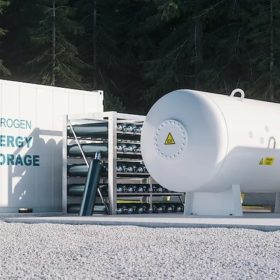Indian researchers develop solar cell from living algae
The researcher team, from Amrita Vishwa Vidyapeetham university in Coimbatore, India, sandwiched macroalgae between a carbon-coated copper electrode and a titanium oxide-coated fluorine-doped tin oxide electrode. The 1 cm2 device exhibited a 1.25 mA photocurrent and 0.5 V photovoltage under UV light.
India’s green hydrogen and electrolyzer market poised for significant growth
The electrolyzer market in India to supply green hydrogen for steel, ammonia, and methanol industries will soar from $4 billion in 2030 to $78 billion by 2050 if the nation stays on track to achieve its declared net zero target.
How safe are lithium iron phosphate batteries?
Researchers in the United Kingdom have analyzed lithium-ion battery thermal runaway off-gas and have found that nickel manganese cobalt (NMC) batteries generate larger specific off-gas volumes, while lithium iron phosphate (LFP) batteries are a greater flammability hazard and show greater toxicity, depending on relative state of charge (SOC).
India extends deadline for submission of R&D proposals under National Green Hydrogen Mission
The Ministry of New & Renewable Energy, Government of India, has extended the deadline for submission of R&D proposals under National Green Hydrogen Mission, to April 27, 2024.
The role of hydrogen in 2024’s energy landscape
With its versatility and potential for decarbonization, hydrogen is scripting a new chapter in the narrative of clean energy.
Italian startup testing PV sleepers on railway line
Greenrail Group has started deploying special its PV railroad-tie solution along a railway line in Emilia Romagna, Italy. The company designed the system according to the UNI 10349 standard.
US government funds pilot project for heated sand energy storage
The US Department of Energy is funding a pilot project to demonstrate the commercial viability of storing energy in heated sand, which is capable of producing 135 MW of power for five days.
Growatt launches new balcony storage solution
The new product combines the NEO 800TL-X Microinverter and the NOAH 2000 Battery. Up to four batteries can be stacked, for up to 8,192 Wh of storage capacity.
The Hydrogen Stream: Companies to close 3 hydrogen stations in Germany
H2 Mobility’s live map has reported the planned closure of at least three hydrogen filling stations throughout Germany in the coming months, while the Japanese government has revealed plans to support the development of low-carbon aviation solutions, including hydrogen-combustion engines.
Polish grid operator switches off gigawatts of PV
Polish grid operator Polskie Sieci Elektroenergetyczne (PSE) has announced its third disconnection of renewable energy capacity this year. This time it has initiated the reduction of 1,201 MW to 1,877 MW of PV in response to oversupply.















